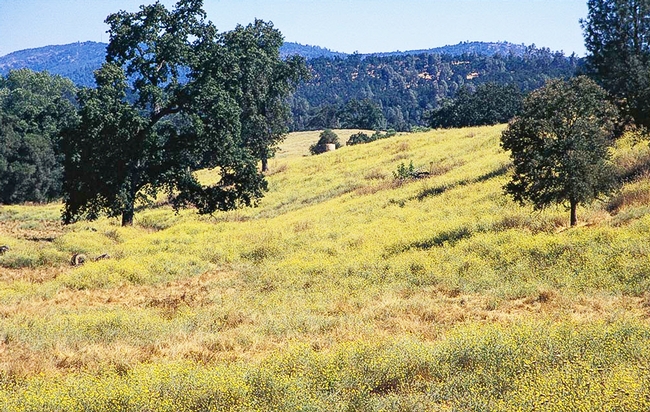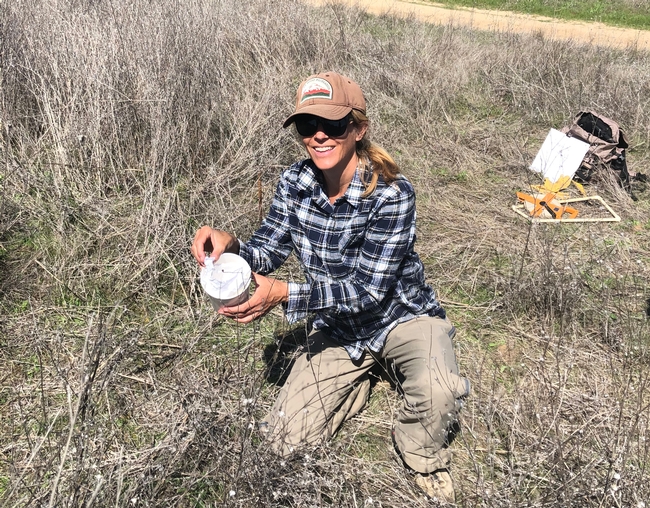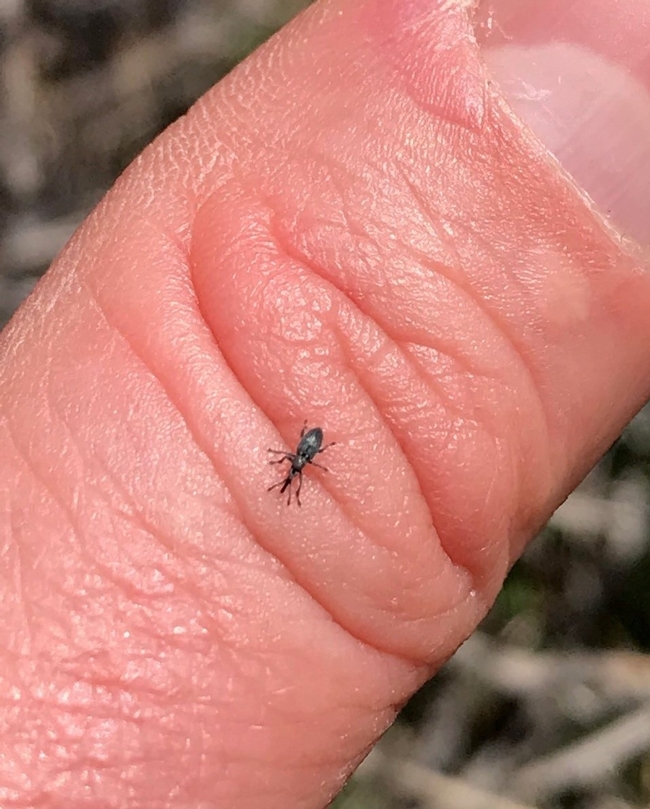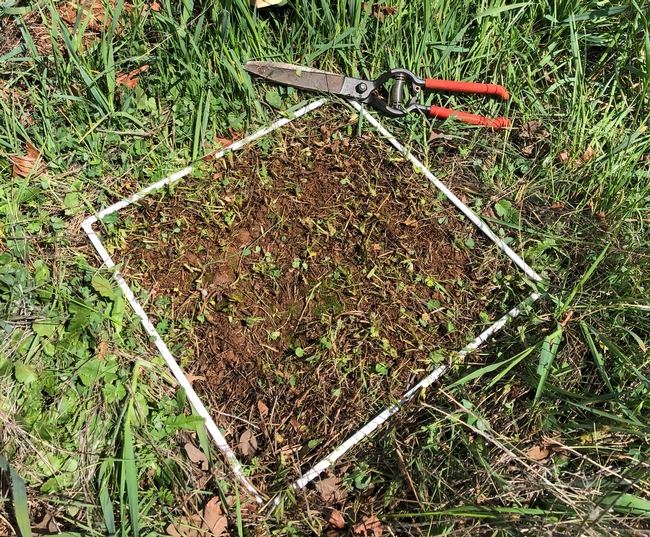Posts Tagged: Scott Oneto
Officials release new weevil to battle yellow starthistle
In April 2021, scientists released weevils from the Mediterranean region of Europe at the Bureau of Land Management Magnolia Ranch day-use area in El Dorado County to join the battle against yellow starthistle. Yellow starthistle rosette weevil is a newly approved natural enemy of yellow starthistle, which was introduced in California more than 150 years ago and, with no natural enemies in its new location, became one of the state's most harmful weeds, infesting nearly 15 million acres.
In California, yellow starthistle can grow to shoulder height, forming massive, thorny patches that block hiking trails, crowd out native plants and present a wildfire danger. The plant is toxic to horses and its flowers are encircled by inch-long sharp spines that can pierce the eyes of grazing animals.
UC Cooperative Extension has worked for decades with landowners to manage yellow starthistle-invested land.
“Over the years, we have developed effective control strategies for yellow starthistle – including well-timed mowing, grazing, hand pulling, burning, cultivation and herbicide application,” said Scott Oneto, UC Cooperative Extension natural resources advisor in El Dorado County. “But these treatments are rarely implemented on a scale large enough to combat our enormous starthistle infestations.”
Efforts to introduce natural enemies from yellow starthistle's home range began in the 1960s. Several species were released to attack starthistle flower heads. These insects lay eggs, hatch and feed on developing seeds, reducing seed production.
“Although the flower head insects sometimes attack high proportions of flowers, yellow starthistle is a very prolific seed producer with an individual plant producing as much as 100,000 seeds,” Oneto said. “Even if the insects reduce seed production by 50%, that still leaves a lot of seeds.”
The newly introduced yellow starthistle rosette weevil, first collected in Turkey as a prospective biocontrol agent in 1984, attacks the plant at the base. Since 2001, United States Department of Agriculture research entomologist Lincoln Smith has studied the insect at the USDA Agricultural Research Service laboratory in Albany.
“Larvae of the weevil develop and feed inside the root crown during spring, adults emerge in June, and then they spend the rest of the year hiding,” Smith said. “There is only one generation per year, so populations will grow slowly, which will gradually reduce yellow starthistle populations.”
The weevil presents no risk to other plants in California except bachelor's buttons, which is an introduced plant from Europe, but not considered a noxious weed. Successful biological control with the weevil is expected to reduce yellow starthistle, but not completely eliminate the weed.
This was the second release of the beneficial insect in North America. The first release occurred in Solano County in April 2020.
Bureau of Land Management and University of California Cooperative Extension researchers will be monitoring the Magnolia Ranch site intensively over the next several years to determine the rate of rosette weevil reproduction and efficacy at feeding on yellow starthistle.
For more information, see A New Warrior Released in the Battle to Control Yellow Starthistle by Scott Oneto on the UC Weed Science blog.
Rancher wisdom can be improved with science
When California was part of the Wild West, it took a certain amount of guesswork to move cattle from their home range to summer pastures while making sure sufficient forage was left behind to hold the cattle over till fall rainfall spurred new growth.
“Ranchers eyeballed it,” said Theresa Becchetti, UC Cooperative Extension livestock and natural resources advisor. “In time, second-, third-, and fourth-generation ranchers got pretty good at deciding, but UC Cooperative Extension introduced a more scientific approach.”
In the spring of 1936, the USDA Forest Services began measuring ungrazed forage at the San Joaquin Experimental Range in Madera County. The project continues today as a joint effort of UC Cooperative Extension and the USDA Natural Resources Conservation Service.
Sixteen years later, just after the UC Hopland Research and Extension Center was established on Mendocino County rangeland in 1951, another study began; and in the early 1980s, scientists at the UC Sierra Foothills Research and Extension Center in Browns Valley commenced a similar long-term study.
As scientists learned of the multiple factors impacting forage production across the Coast Range and Sierra Nevada foothills, some 70 research sites were identified – most on private land - and consistently monitored. The results show that there is much more to understanding forage growth than looking at a rain gauge.
|
Above, watch a full season of rangeland forage growth in one minute. UC Cooperative Extension rangeland and natural resources advisor Royce Larsen set up a camera to capture images of the daily grass growth on Pozo Peak in San Luis Obispo County. |
While high annual rainfall usually results in high forage production and low annual rainfall generally results in low annual production, there are exceptions. It all depends on the timing of the rainfall.
During the devastating drought of 2011-2016, Becchetti noticed forage production didn't mirror the drought damage to state water resources and mountain forests.
“It was interesting,” said Becchetti. “In a lot of my plots, forage would be close to normal. We got rain when the soil was warming up. If we get rain in the late fall or winter, there is no grass production because it's too cool. If rains come when the temperatures warmed up, the grass takes off.”
The expected variation from climate change is another factor that encourages UCCE scientists to conduct routine forage monitoring.
“When I started 11 years ago, we had some good production years; we had poor years, a couple of normal years,” Becchetti said. “Monitoring is giving us a better snapshot that all of us can use to see the impact of climate change on forage production.”
To develop an accurate picture of forage growth, the research locations are fenced or caged to keep out grazing animals. Grass and forbs within one square foot of the exclosure is clipped to the ground. The vegetation is dried, weighed and the figures logged in a database.
Long-term production data are particularly valuable for the three research stations because daily weather data that are also collected there can be used to determine the effects of rainfall and temperature on annual forage productivity.
Year-to-year variability at the Hopland research site ranged from 900 pounds of forage per acre in the poorest year, up to a 3,500 pounds per acre bounty when conditions were just right. Average annual production at Hopland is 2,399 pounds per acre. At the Sierra Foothill Research and Extension Center, annual forage ranged from a low of 1,071 per acre up to 4,696 pounds per acre. The average annual production there is 2,971 per acre.
“There is no way we could represent the exact forage production across the state, but this does allow us to come up with a percent either below or above normal for a particular area,” Becchetti said.
The monitoring research conducted by UCCE scientists are important to provide guidance to county agricultural commissioners and local Farm Service Agencies.
“If you think about it, so many of our ag commodities are based on weight or volume,” said Scott Oneto, UCCE rangeland and natural resources advisor in El Dorado, Tuolumne, Calaveras and Amador counties, where annual monitoring has been conducted for 25 years. “But annual rangelands are so different when it comes to figuring out whether a given year is average, above average or below average. And when crop insurance is involved, it makes it very difficult for ag commissioners to declare a loss if they don't know what the loss is or if there even was one.”
Becchetti, along with 14 current and former UCCE colleagues, wrote a 12-page review of UCCE's ongoing range forage production study, which includes average production for many of the study sites. ANR Publication 8018 is available for free download from the UC ANR publication catalog.
Beautiful but ecologically harmful shrubs get a foothold in California forests
A glorious foothill display of yellow flowers and their spicy-sweet fragrance may delight the senses, but they pose a serious problem for California.
Scotch, Spanish and French broom were introduced from Europe in the mid-1800s as lovely, easy-to-grow garden accents and land stabilizers, but they have become aggressive invaders threatening native plants and increasing fire hazards.
“These brooms crowd out our native flora and form large, dense stands of just broom,” said Scott Oneto, UC Cooperative Extension advisor in the Central Sierra. “It’s also displacing the birds and animals that would live in this environment with native plants.”
The characteristics of invasive brooms cause several problems. The plants grow large and upright, developing thick trunks at the base. After its relatively short life span - typically 7 to 8 years, 15 at the most – they die and become tinder-dry woody skeletons that can burn high and hot.
The brooms are also a member of the legume family. Legumes are unique in the plant world. They have evolved a symbiotic relationship with bacteria that live on their roots. The bacteria are able to pull nitrogen from the atmosphere and deposit it into the soil, where it feeds the plant.
“These soils are naturally very low in nitrogen,” Oneto said. “Our native plants thrive in low-nitrogen soils. Large populations of broom are changing the soil chemistry so even after they are removed, the area is no longer ideal for our native vegetation.”
Large stands of broom are also a significant concern for rangeland managers. Cows don’t like the taste; only goats will eat it. When the plant is grazed off or cut back, it readily re-sprouts from the crown. The plant’s spread is bolstered by its intriguing ability to scatter seeds widely. Brooms grow seed pods that are naturally spring loaded. When the seeds are ready for dispersal, they fling from the pod with the force of a tiny explosion.
In collaboration with the non-profit California Invasive Plant Council, which received a grant from the Sierra Nevada Conservancy, Oneto is working to eradicate broom from a particularly sensitive location. Highway 120, for many the “gateway to Yosemite,” has populations of French and Spanish broom.
“We’ve started by mapping the broom along Highway 120 and plan to eliminate the population to prevent it from moving further into the forest and eventually into Yosemite National Park,” Oneto said.
The grant is providing the funding for environmental and regulatory compliance so that control measures can be implemented.
“Once the regulatory compliance is complete, the project will be shovel-ready and we can begin treatment,” Oneto said.
“If broom is growing wild or as an ornamental on your property, we suggest you remove it and replace it with a non-invasive plant,” said Rebecca Miller-Cripps, natural resources program representative with UCCE Central Sierra. For example, forsythia produces yellow flowers and a shrub of about the same size and shape as brooms, but isn’t invasive, she said.
For more about invasive broom, see the video below:
Multi-county partnerships saving county and University funds
Scott Oneto, the director of the first UC Cooperative Extension multi-county partnership UCCE Central Sierra, told the Amador County Board of Supervisors that the new organizational structure has saved participating counties and University funds while supporting local programs, reported Jim Reece on TSPNTV.com in Amador County.
Four counties contributed funds to the partnership: Amador County, $134,000; Calaveras County, $148,000; Tuolumne County, $144,000; and El Dorado County, $270,000. The 2011-2012 budget also included $590,000 in grants, $450,000 in federal and state funding and $110,000 in fundraising and indirect county funding, Oneto reported to the Board.
In all, UCCE Central Sierra ended the year with a budget of $3.025 million. The complete 2011-2012 Annual Report is available online (pdf).
Scientists to minimize impact of High Sierra grazing
University of California, U.S. Forest Service and other agencies will work together to understand the impact of cattle grazing in the High Sierra and look for solutions to water quality problems, according to an article in the Sonora Union Democrat.UC Davis Cooperative Extension watershed specialist Ken Tate and interim director of the Western Institute for Food Safety and Security at UC Davis Rob Atwill will design and conduct the study. The first samples have already been collected.
In the story, writer Ashley Archibald reported that the scientists are seeking to fix problems, not just document them.
“It’s good to focus on what are the practices that can move us forward so everyone can enjoy the national forest since it has a multiple use mandate and is a resource for the public, and the public is pretty diverse," Atwill was quoted.
Scott Oneto, the director and farm advisor for the UC Cooperative Extension in Calaveras and Tuolumne counties, said the scientists are still looking for input on how to build a comprehensive study.
The California Farm Bureau Federation's weekly publication AgAlert
also weighed in on the new study. The paper said the scientists held a briefing for ranchers in Sonora where they explained their desire to acquire data to demonstrate the relationship between grazing on public lands and water quality requirements.
The article - written by AgAlert editor Kate Campbell - noted that the scientists will take multiple water samples from 48 different sites in the High Sierra over the next several months, with preliminary results available by the end of this year. Sites will include areas used for grazing and recreation.








